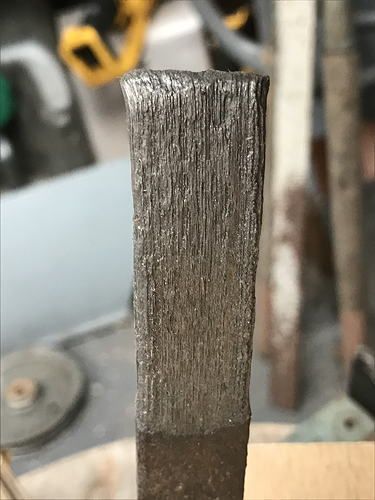If Frank's object isn't Wrought Iron, I'll eat it!

The structure is due to the way the Iron was purified by repeated hammering.
Before about 1850, the chemistry of metal making was poorly understood and results depended on trial and error methods skillfully adapted to local conditions. The problem was impurities: Carbon and Manganese are 'good', Sulphur and Nitrogen are bad, and many others including Phosphorous, Silicon, Molybdenum, Nickel Silicon, Boron, Arsenic, Aluminium, Lead, Tungsten, Chromium, Vanadium, and Cobalt have good effects in carefully controlled proportions, otherwise bad. Understanding the chemistry makes an enormous difference.
Wrought Iron dates from the time when the best that could be done with dirty Iron was encourage impurities to dissolve into the slag in a low temperature furnace and then beat the slag out of the semi-molten metal/slag mix by repeatedly folding and hammering it. The more this was done the better and it's expensive.
The notion metals have more or less 'quality' come from the prescientific period because metals became purer the more they were skilfully re-heated and hammered or otherwise processed. More art than science, and more than a bit magical.
Buying metal for a purpose meant choosing it from a particular area and from the particular manufacturer who got closest to your requirement. Buyers had to understand the merits of iron variants produced by Carron, Buffery, Elsicar & Milton, Coed Talon and many other small makers, and why the iron was supplied in different forms: Best Bar Iron, Soft bar Iron, Cold Short Bar Iron, Hard Bar Iron etc. The amount of effort put into refining was often indicated by multiplying adjectives, such as 'Best Best Best Iron'. Processing often went wrong, and the accounts of early engineers are full of complaints about the random properties of what they got from the trade.
Between 1850 and 1860 Bessemer revolutionised the production of steel by realising that blowing air through a large charge of molten iron and coke would remove many impurities whilst also controlling the amount of Carbon in the mix. The resulting mild-steel was an excellent substitute for Wrought Iron: much cheaper, stronger, and without the layer structure that gives Wrought Iron high tensile strength along the grain but leaves it weak in other directions.
Mild-steel is also easier to machine, and can be mass produced even more cheaply simply by scaling up the furnace. The main disadvantage of mild-steel is it rusts.
A huge step forward but Bessemer almost came unstuck because he tested his new process with a low-phosphorous ore. It worked a treat, but the Bessemer process failed when tried with iron made high-phosphorous ore, a common type. Fixed by a chemist who analysed good and bad steels, and spotted Phosphorous was the problem and that it could be removed by lining the furnace with a suitable basic material.
The original Bessemer mild-steel was inferior to modern mild-steel because blowing air through the mix left Nitrogen in the alloy, another problem it took a chemist to identify. Fixed by blowing Oxygen extracted from air instead of compressed air.
Modern metal production is a far cry from melting stuff in a pot and relying on artisans to improve it! Although production can and does go wrong, it's far more reliable than earlier methods. For example, a rough analysis of the content of a molten mix with laboratory methods circa 1900 took over 30 minutes, too long to fix certain problems, whereas modern methods get an accurate analysis of the mix almost in real time, making it much easier to correct problems by adding chemicals, changing temperature, or whatever.
In it's day Wrought-Iron was a top engineering material, extremely useful and costly. Now rarely made and only in tiny quantities. It's almost exclusively used for high-end decorative iron-work, because it blacksmiths, looks good, and is low-maintenance.
Dave
Nigel Graham 2.












